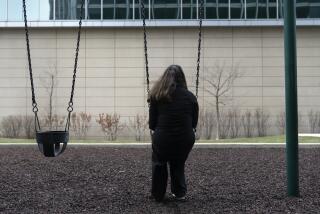
- Share via
Exposure to unhealthy levels of air pollution during pregnancy may prolong postpartum depression symptoms in new mothers, according to new research.
A team of researchers from the University of Southern California assessed the air quality in the communities of more than 350 pregnant women across Greater Los Angeles from 2015 to 2023. The researchers then tracked the women’s mental health for up to three years after they gave birth.
Scientists found that the women who were exposed to higher levels of nitrogen dioxide and inhalable particulate pollution — two prevalent forms of air pollution — during their second trimester were nearly four times as likely to experience depression up to 3 years after their pregnancy.
Exxon Mobil has touted ‘advanced recycling’ as a groundbreaking technology that will turn the tide in the plastic crisis. California says it’s a lie.
Poor air quality has been identified as one of several factors associated with postpartum depression, a serious mental health condition often associated with intense feelings of sadness and difficulty bonding with a newborn.
The new research highlights the need for mental health screenings beyond the 12-month postpartum period, according to study co-author Tracy Bastain, an associate professor of clinical population and public health sciences at the Keck School of Medicine at USC. It also suggests women may need to be particularly vigilant about minimizing their exposure to air pollution when they are four to six months pregnant.
“There’s a lot of changes in pregnancy that happen to a woman’s body as she is getting ready to prepare her body for delivery,” Bastain said. “There are changes in heart rate, in blood volume, and in respiration — all of these types of physiological changes occur because there’s a body that’s growing inside of her body. And because of that, we think of this [second trimester] period of pregnancy as potentially a vulnerable period for environmental exposures, including air pollution.”
In Southern California — a region that endures some of the highest levels of air pollution in the nation — evading harmful emissions can be a challenge.
Nitrogen dioxide, a lung-irritating gas and component of smog, is nearly inescapable as it is produced by the burning of fossil fuels. Gasoline-powered cars and natural gas-burning stoves are just two common sources of NO2.
Inhalable particulate matter, or PM10, includes such debris as dust, pollen, wildfire ash and soot.
Some of the largest sources of NO2 and PM10 are Los Angeles’ congested roads and highways. Although exercise and outdoor activity are encouraged for pregnant women, Bastain said it’s important to avoid motorways, especially during rush hour and the hottest hours of the day.
But traffic-related pollution is an unfortunate reality for many disadvantaged communities. Bastain and other USC researchers have monitored a group of women — and their children — for about nine years to better understand how environmental conditions, diet and consumer products may influence maternal health. Most of the participants are low-income Latinas, who Bastain said may be more at risk for depression due to financial constraints and difficulties overcoming language barriers within the healthcare system.
In the air quality study, more than 17% of women reported having depressive symptoms one or two years after giving birth. About 13% of women still experienced these symptoms after three years.
Maternal Mental Health Now, an L.A.-based nonprofit, was founded in 2007 by Kimberly Wong, a local attorney who experienced severe postpartum depression and who felt her symptoms were largely dismissed by her doctor. It motivated Wong to create the organization to address the lack of awareness and training among healthcare providers about these mental health disorders, according to the organization’s executive director Kelly O’Connor.
COBB Tuning produced and sold aftermarket accessories at several retail stores, including a former location in Fountain Valley.
“Upon her recovery, she said, ‘If I had so much trouble finding the resources I needed — and I am well educated, I speak English, I have good health care and a supportive husband and family — what would someone without those resources do in my situation?” O’Connor said.
Without the proper resources, depression and mood disorders can continue to linger.
“If it goes unidentified or untreated, it can last longer than 36 months,” O’Connor said.
The USC study joins a growing body of research linking air pollution to depression, anxiety, cognitive decline and other neurological conditions. The findings underscore the importance of studying air quality more broadly as it relates to health.
“Air pollution was traditionally thought of as a type of exposure that impacts the lung,” Bastain said. “But over the last couple of decades, I think there’s been realization and acknowledgment that air pollution has much larger systemic effects. And one of those areas that began to be investigated in the 2010s were effects directly on the brain.”
Toward a more sustainable California
Get Boiling Point, our newsletter exploring climate change, energy and the environment, and become part of the conversation — and the solution.
You may occasionally receive promotional content from the Los Angeles Times.









